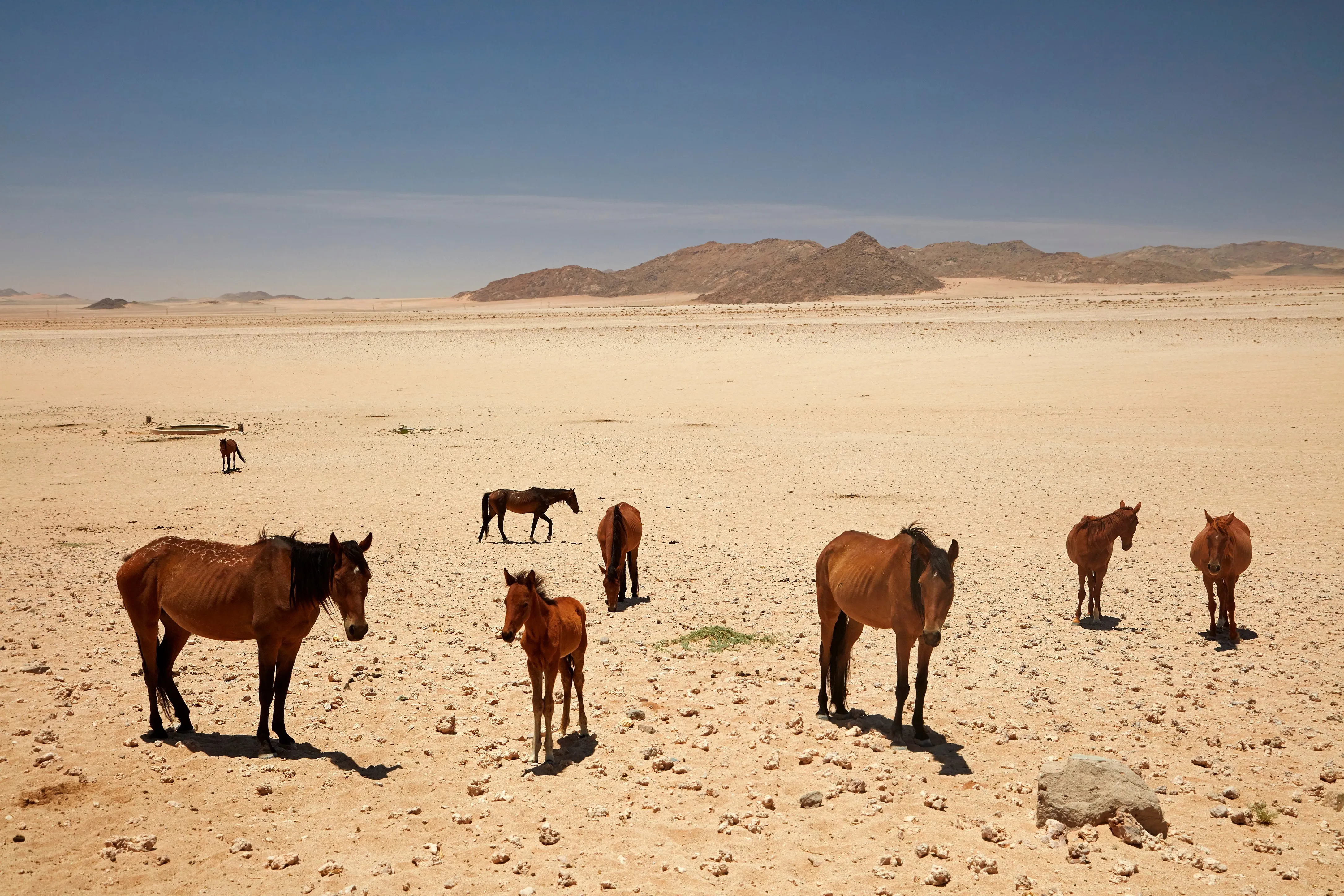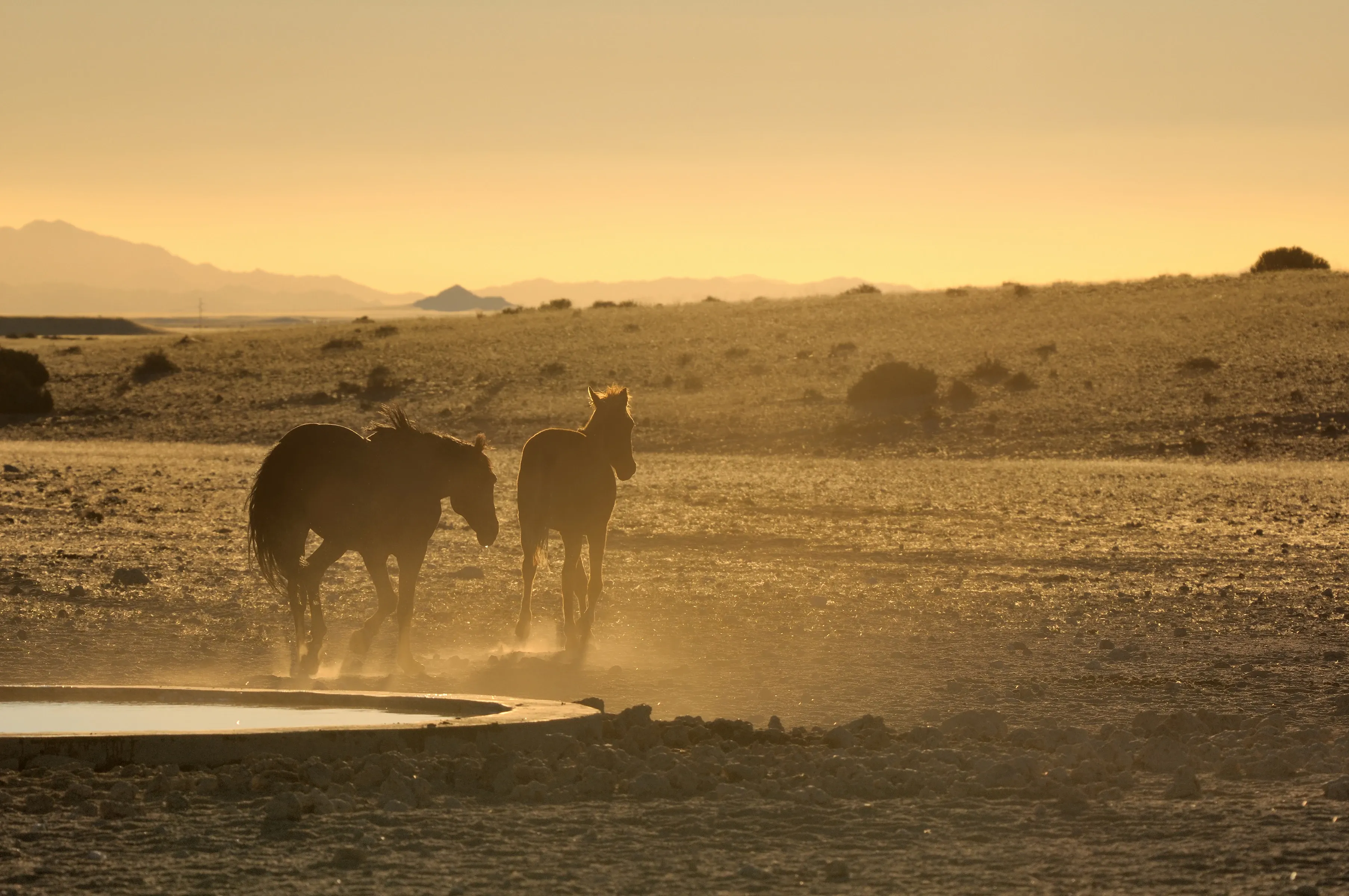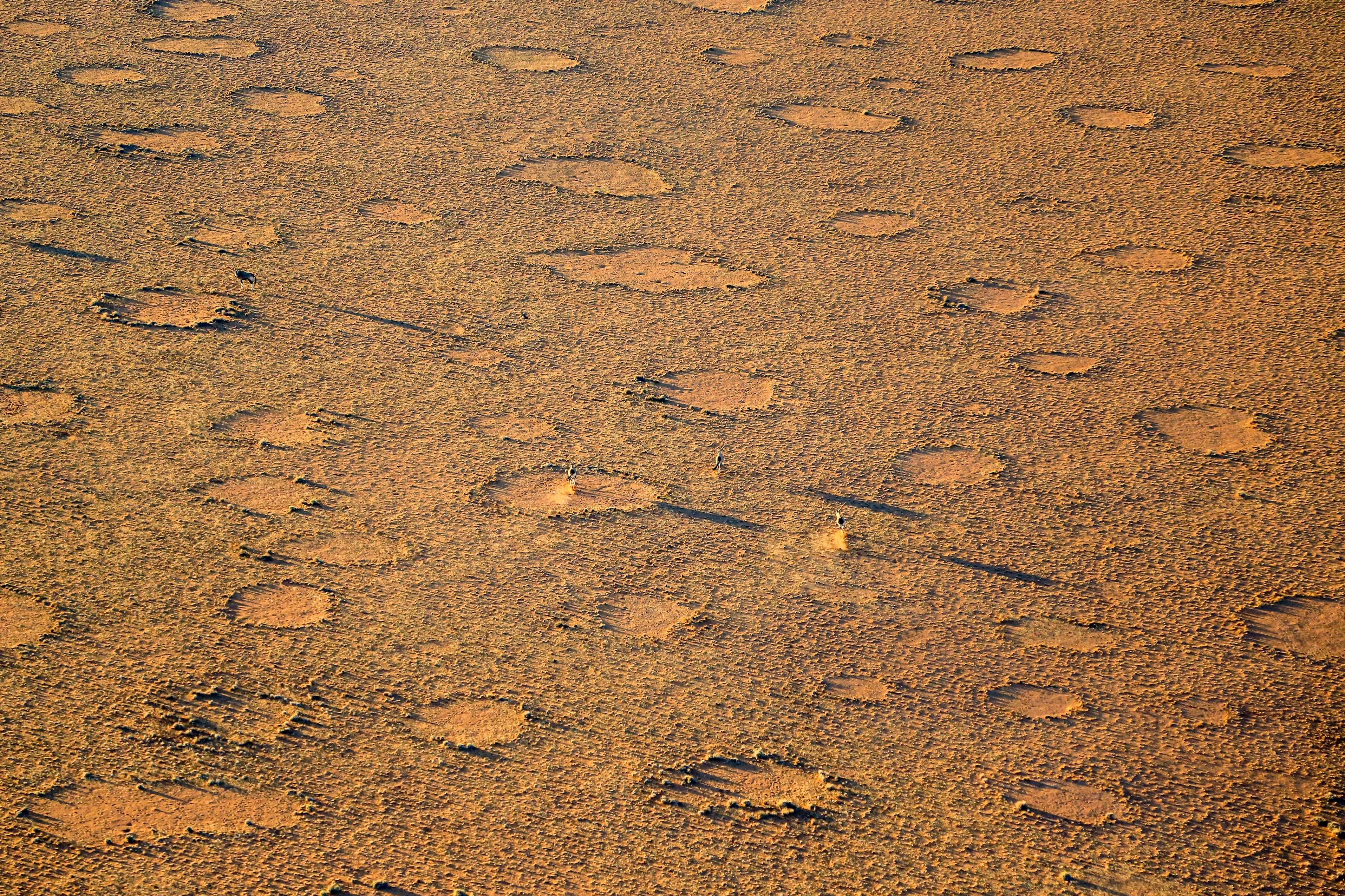The tough wild horses of the Namib
The sun burns mercilessly on the exhausted land. Rocks. Boulders. Sand. Here and there a patch of dried, yellow grass. The Namib. One of the driest areas on earth. The burning heat fills the vast emptiness. Only those who can withstand sand, storm, drought, and heat survive here. As specialists, some species have adapted to this habitat for thousands of years.
But one species is making its way as a newcomer: the tough Namibs - offspring of horses that came to this desert only 100 years ago. They make this region unique. They make it Africa's Wild West.

Where do the wild horses in Namibia come from?
Horses are not native to Southern Africa. The climatic conditions here are untypical for equines. Horses were imported by the European immigrants with the settlement of Southern Africa. Similar to the American mustang, the horses living wild in Namibia are said to be the offspring of European domestic horses that have run wild.
There are different theories about the origin of today's wild horses, but there is no consensus. Horses were bred as working and racing horses in the Namib Desert area. Here, animals could have escaped or been set free. It is also possible that the wild horses are the offspring of horses that once belonged to the German troops, who lost their owners in 1915 when the Germans retreated from the South African army.
Alternatively, the horses may have escaped from South African soldiers during the First World War. German planes bomb the South African camps. It is estimated that 1,700 of the 6,000 stationed horses survived and found their way into the desert. Another theory on the origin of the wild horses refers to the stranding of a German baron at the end of the 19th century, who had bored horses, among other things.
»"A conflict occurs when two stallions get too close to each other at the water trough or when a mare in heat is nearby."«

Diamonds: Fundamental building block of a new species
In 1908, the first diamond was found in the Garub area. Consequently, an enormous restricted area was established that extended 100 km inland from the coast. In this area were also the escaped horses. No unauthorised person was allowed to enter the desert. This implies it was also closed to hunters and horse traders.
Therefore, the horses remained undisturbed for over 80 years and were able to adapt to the harsh conditions. Today, the once runaway domestic horses are referred to as a separate species - the "Namibs". The Namibs have developed into a new breed of their own throughout the decades.
Artificial water source – The Garub borehole as an elixir of life
In only a few places in the Namib Desert is life plentiful. But the borehole for water in Garub, which was once used to supply water to the nearby railway line, attracts a great variety of living creatures. The borehole developed into a watering hole. Survivalists come from all over to quiet their thirst. For the horses, in particular, this artificial watering hole is the centre of their lives. They are not evolutionarily prepared for life in the desert. Thirst forces them back again and again to the man-made oasis.
What do horses eat in the desert?
In good years, the desert offers enough space and sufficient food. But again and again, their habitat is plagued by drought years. In dry years, the animals must move deeper into the Namib to find anything edible. With each day without rain, the grass becomes less and less. During these times, the food search is often unsuccessful. Starvation occurs. Weak animals die. A public uproar follows. In bad years, the horses depend on the goodwill of humans. But despite all efforts, the population declines sharply during these times.
If they occur, short, small-scale rainfalls create pastures. The search for precisely these grazing areas as a food source determines the life of the Namibs. They travel up to 40 km to search the limited food before returning to the only artificial waterhole.
They mainly eat the dry grass that grows waist-high here in wet years. After a long drought, however, the grass is very dried, short and lacks nutrients. Besides that, they eat dry branches and roots.
There is no access to fertile areas. The enormous 160-kilometre-long Fish River Canyon blocks the way to the south. As a result, the former domestic horses remain prisoners of the desert — life on the edge of existence.

Doomed to die as offspring
Up to 20 mares and foals form a so-called breeding group with one or two stallions. The leading stallion decides when to go to or from the pasture or drinking trough. The drought determines the whole life of these animals. Not only food but also reproduction is defined by it. Offspring are only born when there is enough food to ensure their survival.
In July, when it is winter in Namibia, foals are born after 11 months of pregnancy. Sand. Wind. Drought. They are also the first impressions of the newborn and will accompany it throughout its life. After 15 minutes, it is already standing on its legs to reach the teats of its mother mare. Only a little later, it moves along under the protection of the herd.
Half of the newborn foals often die in the first weeks in the hostile world they are born into. During the day, the sun heats the land to over 50 degrees Celsius. At night, temperatures drop below freezing. Other enemies lurking in the desert include spotted hyenas.
Again and again, the mother animals are faced with a difficult decision. Does the mare stay with her skinny, weak foal and risk starving herself? Or does she leave her young one behind and move on with the herd when the foal is too weak to stand up. It is a true miracle when a foal in the Namib survives to adulthood.
»Inbreeding is not yet a problem for the wild horses yet.«
Threats: Struggle for survival in Namibia
In good years, up to 280 horses gather at the waterhole of Garub. In bad ones, it is less than 100. If the Namibs’ population drops below 50, the survival of their species is in danger.
In horses, mares choose their mates. They always look for a stallion to whom they are not related. But due to the drastic population reduction during the droughts, the gene pool is getting smaller and smaller. The horses' hips are often open and bloody. Injuries plague many horses. They use their tail to shoo flies out of their wounds. Those Injuries come from attacks from enemies or fights with other horses.
They are meagre at the end of summer. The ribs are clearly visible under the skin. The lack of nutrients drives many animals to death. At this critical time, they begin to eat their own manure because it contains more protein and more fat than the dry grass. Animals are often seen licking the dried sweat off each other's fur as a source of minerals.
The fight seems like mad exuberance, given the heat and scarce food. However, it is about the survival of the fittest.
Should the horse live here or not?
Conservationists have different opinions on whether the Namibs are worth protecting. Opponents argue that the introduced species would stress fragile ecosystems, displace native animals and wipe out sensitive plants. In fact, four different types of desert vegetation converge in the Aus region, supporting more than 500 species of plants. Many species are native to the area, and some are endemic. Should they be eaten the by offspring of German war horses? Some employees of the Namibian Ministry of Environmental Protection refer to the animals pejoratively as "donkeys".
The image of the animal first improved after Grayling's study. She demonstrated that the horses' habitat occupies less than 1 % of the national park area. According to Grayling, water scarcity impacts plant growth more than horses. Furthermore, competition for food between horses and game is not obvious.
»We should protect these horses because they are part of our history.«

The importance of wild horses for tourism
In 1986, 350 square kilometres of the former diamond restricted area were incorporated into the Namib-Naukluft Park. Today, the wild horses are still one of the leading tourist attractions in the southwest of the country and thus provide income and jobs in the country.
Not far from the watering-place at Garub, which is the Namibs' centre of life, a wooden shelter has been erected from which the wild horses can be observed, protected from the heat.
Source references:
Nordpolfilm - YouTube
Info Namibia
Süd-Afrika Magazin
ServusTV
Sign up for the newsletter
By clicking on “Subscribe now” I will subscribe to the Conscious Explorer newsletter with all the information about mindful travel. Information on the success measurement included in the consent, the use of the shipping service provider MailChimp, logging of the registration and your rights of revocation can be found in our privacy policy.










